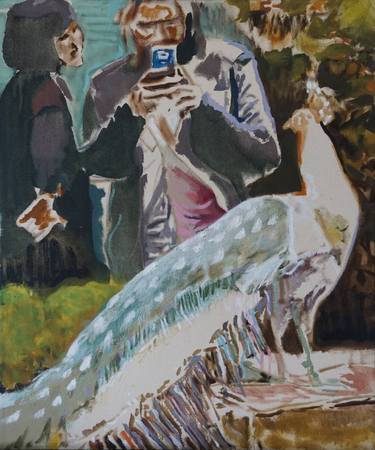Why Figurative Oil Painting Remains a Classic Choice for Artists
Why Figurative Oil Painting Remains a Classic Choice for Artists
Blog Article
The Duty of Emotion and Expression in Figurative Oil Paint: A Comprehensive Analysis of Subject and Make-up
The interplay of feeling and expression in figurative oil painting acts as a vital lens where one can examine the intricate connection between topic and composition. Artists harness various strategies, from color option to brushstroke dynamics, to cultivate emotional vibration within their jobs. This nuanced orchestration not only shapes viewer assumption however additionally welcomes a deeper questions right into how these aspects coalesce to show the intricacies of human experience. As we explore this abundant terrain, one need to take into consideration how particular case studies brighten the more comprehensive ramifications of these creative options.
Comprehending Feeling in Art
Feeling in art works as an effective conduit for expression, allowing musicians to share complicated feelings with their job. In figurative oil painting, this psychological depth is usually portrayed through the representation of the human number, recording the subtleties of human experience. The selection of topic, color palette, and brushwork all add to the emotional vibration of a piece.
Artists often draw upon individual experiences, social concerns, or universal themes to stimulate feelings in the customer. A portrait may show susceptability, while a dynamic number in movement can represent freedom or chaos. These emotional strings connect the visitor to the art work, promoting a dialogue that goes beyond the aesthetic medium.
Additionally, the interaction in between light and darkness can intensify psychological intensity, guiding the viewer's look and attracting interest to specific components within the composition. The usage of structure in oil painting additionally includes layers of intricacy, inviting a responsive response that enhances the psychological experience. On the whole, understanding feeling in art is crucial for appreciating the nuances that characterize metaphorical oil paint, as it changes mere depiction right into an extensive exploration of the human condition.
Trick Aspects of Composition
In the realm of figurative oil painting, the make-up offers as the underlying framework that organizes visual components and enhances the psychological narrative. Important elements of composition consist of equilibrium, contrast, centerpiece, and rhythm, each adding to the general impact of the artwork.
Equilibrium refers to the circulation of aesthetic weight within the painting, which can be achieved with asymmetrical or symmetrical setups. A healthy make-up provides security, enabling the audience to involve with the piece harmoniously - figurative oil painting. Comparison, on the various other hand, involves comparing different components, such as dark and light or cozy and awesome colors, to assist the visitor's eye and stimulate emotional reactions
The focal factor is essential, as it guides focus to the most significant part of the paint, frequently highlighting the emotional core of the narrative. By skillfully integrating these vital elements, artists can craft emotionally resonant and compelling metaphorical oil paintings that captivate and engage their audience.
Subject Matter and Its Influence
Subject plays a pivotal function in figurative oil paint, as it not only offers as the structure for the story but likewise forms the audience's interpretation and psychological involvement with the art work. The option of topic-- be it a singular number, a team dynamic, or a thematic representation-- straight influences the emotional environment communicated to the audience.

For example, pictures often evoke individual connections, revealing the intricacies of human expression and personality, while scenes portraying common tasks can create a sense of belonging or nostalgia. In addition, the historical and social context of the subject enhances the viewer's understanding, triggering much deeper representations on social standards, values, and the human problem.
Different subjects additionally create differing degrees of interaction; a remarkable dispute shown through figures in stress may elicit sensations of stress and anxiety or empathy, while peaceful landscapes can invoke peace and reflection. Ultimately, the effect of subject in metaphorical oil painting is extensive, as it acts as a conduit for psychological vibration, assisting the visitor's feedback and analysis, and promoting a connection in between the viewer and the artwork. This interaction is crucial for the effective communication of the artist's intent.
Techniques for Stimulating Feelings
The effectiveness of figurative oil paint in conveying feelings is dramatically affected by the techniques utilized by the artist. Among one of the most crucial techniques is using shade theory, where the strategic option of colors can stimulate certain psychological actions. Cozy shades, such as useful content reds and oranges, typically evoke sensations of interest or aggression, while cooler tones like blues and greens have a tendency to evoke peace or unhappiness.
Another vital strategy is the adjustment of light and darkness, called chiaroscuro. This technique enhances the three-dimensionality of numbers, producing dramatic contrasts that can increase emotional deepness. The placement of light can assist audiences' emotions, highlighting particular aspects of the make-up.
Brushwork additionally plays a vital function; loose, meaningful strokes can convey power and spontaneity, whereas smoother techniques might recommend harmony or precision. Additionally, the setup of topics within the make-up can affect psychological effect. Close proximity can suggest affection, while range might show seclusion.
Ultimately, the combination of these strategies makes it possible for artists to craft narratives that resonate with the customer, changing a mere aesthetic experience right into an expressive psychological journey. - figurative oil painting

Instance Researches of Notable Works
Checking out notable jobs of metaphorical oil paint exposes how numerous techniques are utilized to stimulate powerful feelings. One exemplary instance is Edvard Munch's "The Scream," where the distorted number and swirling background communicate existential fear. Munch's use of shade-- vivid oranges and deep blues-- heightens the emotional impact, showcasing how combination choices can form customer experience.
One more significant job is Pablo Picasso's "Les Demoiselles d'Avignon." Right here, bold brushstrokes and fragmented types reflect a troubled emotional landscape, challenging typical representations of the female figure. Picasso's innovative structure not just catches the audience's interest however also invites consideration on themes of identity and sexuality.
Furthermore, Frida Kahlo's "Both Fridas" offers an emotional exploration of duality and self-identity. The contrasting figures, connected by a common heart, exemplify Kahlo's emotional deepness and personal narrative. figurative oil painting. Her thorough attention to information and symbolic elements offer to engage visitors on a visceral degree
These case studies emphasize the profound connection in between emotion and composition in figurative oil painting, disclosing exactly how artists harness technique to connect intricate feelings and stories that reverberate throughout time and society.

Final Thought
To conclude, the interplay of emotion and expression in figurative oil paint dramatically enhances the visitor's experience and analysis of the art work. Through a cautious option of topic and compositional methods, artists communicate profound stories that resonate on both global and individual degrees. The application of shade brushwork, chiaroscuro, and concept further magnifies sites psychological depth, changing each canvas right into an effective representation of the complexities of the human experience.
In metaphorical oil painting, this psychological deepness is commonly represented with the depiction of the human number, recording the subtleties of human experience.In addition, the interaction between light and shadow can intensify you can find out more psychological intensity, assisting the customer's stare and drawing focus to certain components within the composition. The use of appearance in oil paint even more adds layers of complexity, welcoming a tactile response that boosts the emotional experience.The focal factor is crucial, as it guides interest to the most considerable component of the painting, usually highlighting the emotional core of the narrative. Eventually, the effect of subject matter in figurative oil paint is extensive, as it serves as a conduit for psychological resonance, guiding the viewer's response and analysis, and promoting a connection in between the artwork and the viewer.
Report this page